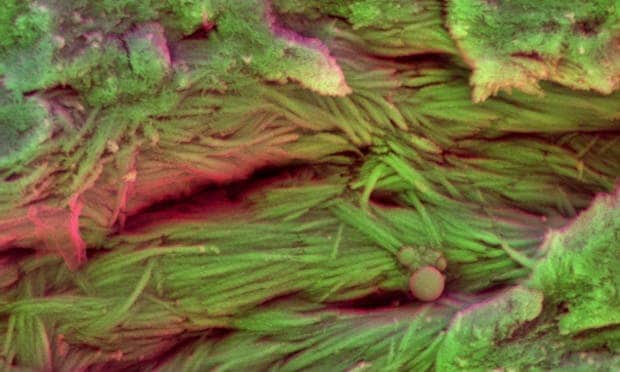Traces of soft tissue and red blood cells were discovered by accident by a team of paleontologists and biologists while they were playing around in the lab with so-called “crap” fossils dug up more than 100 years ago in Canada. Usually, museum curators are very proud and picky about the works they display or hold in storage, and any analysis that involves breaking or sectioning a fossil is most often than not strictly forbidden. But these fossils – like a claw from a meat-eating therapod, the limb from a duck-billed dinosaur and even the toe of a triceratops-like animal – were fragments in poor conditions that nobody really cared about. One man’s trash, another man’s treasure.

The bits and pieces nobody thought too impressive, to say the least, were dug up from the Dinosaur Park Formation in Alberta, Canada more than a century ago. Somehow these made their way into the massive storing rooms of the National History Museum in London. Susannah Maidment, a paleontologist at the Imperial College in London, got ahold of eight such fossils and together with Sergio Bertazzo, a materials scientist at Imperial, analyzed them. To their surprise, when the fossils were studied using an electron scan microscope they found evidence of soft tissue. ‘Wait – that looks like blood!’,” Bertazzo said.
Suffice to say this sort of finding is extremely rarely reported, especially in fossils these old – at least 75 million years old. At first, Bertazzo thought that maybe the blood cells were actually from some human who had accidentally got cut and sprayed blood over the ancient bones. If it was human blood he was seeing on the microscope, and not dinosaur blood, then the red cells should have lacked a nucleus (a mammalian trait). But they did found a nucleus. “That ruled out someone bleeding on the sample,” said Maidment.
The team also spotted bands of fibers on the fossils. Tests showed these contained certain amino acids associated with collagen – the basis for skin and tissue. This proteins are thought to degrade completely after 4 million years This begs the question, is there some DNA too? Is this the holy grail scientists have been waiting for – the foot stone for a real-life Jurassic Park?
“We haven’t found any genetic material in our fossils, but generally in science, it is unwise to say never,” said Maidment.
Bertazzo skeptically added: “This opens up the possibility of loads of specimens that may have soft tissue preserved in them, but the problem with DNA is that even if you find it, it won’t be intact. It’s possible you could find fragments, but to find more than that? Who knows?”

Nevertheless, the findings are quite important if we consider how often something like this could happen. I mean, if they found such amazingly preserved tissue samples in random fossils, what about the hundreds of thousands of other items? How common is this? Intuition tells us that this is far from a needle in a haystack success story. As such, the paper published in Nature Communications will likely serve as an inspiration for other pathologists to brush up some of the fossils from their dusty drawers and start inspecting for similar clues. Of course, this means sectioning some of the items, but there’s load of ancient ‘crap’ lying around in museums all over the world. Make some good use of them.
Also, the blood samples are particularly intriguing. Birds are the direct decedents of dinosaurs, but while the latter were cold blooded, the avian family is worm blooded. How did this evolutionary transition happen? What were the mechanism involved? Further findings might shed light.


